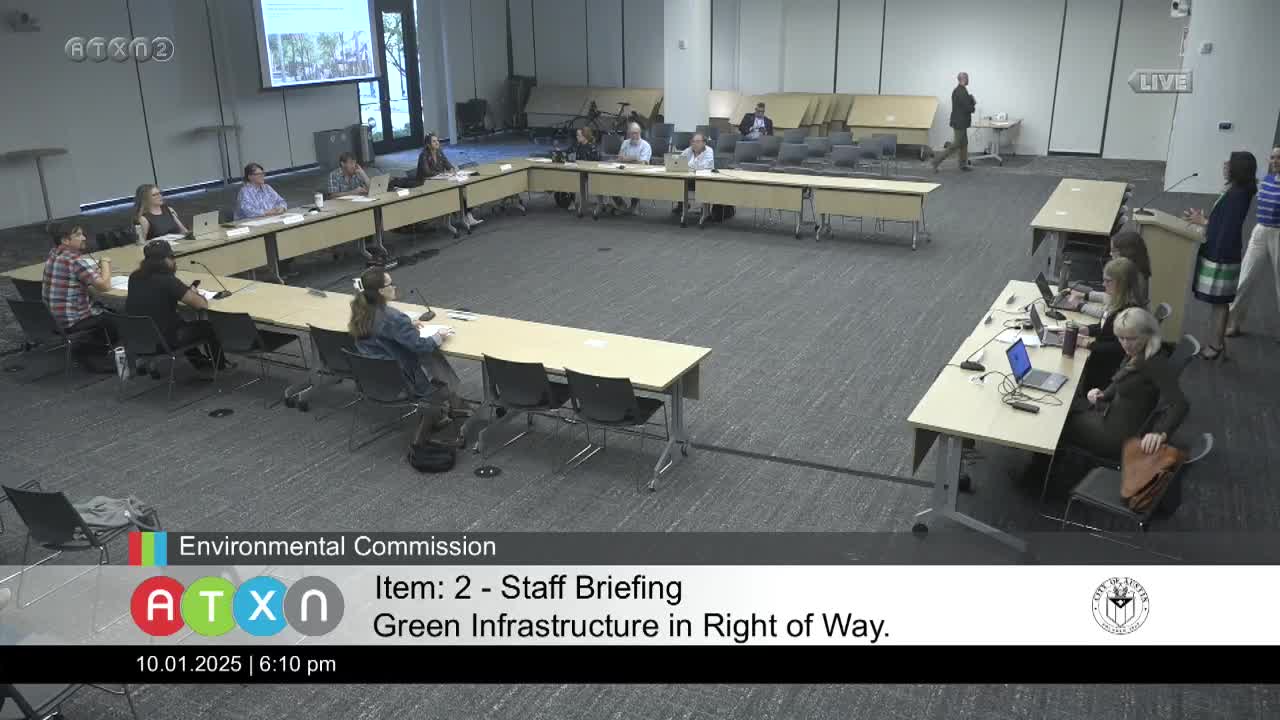Austin Council Tackles Barriers to Street Tree Planting Infrastructure
October 01, 2025 | Austin, Travis County, Texas
This article was created by AI summarizing key points discussed. AI makes mistakes, so for full details and context, please refer to the video of the full meeting. Please report any errors so we can fix them. Report an error »

The Austin Environmental Commission meeting on October 1, 2025, focused on the critical role of street trees in enhancing urban infrastructure and environmental sustainability. Naomi Richmel, the City Arborist, presented the numerous benefits of street trees, emphasizing their importance in heat mitigation, air quality improvement, and stormwater management. Richmel noted that street trees can lower temperatures by an average of 10 degrees, making them vital in combating the extreme heat often experienced in Austin.
Richmel highlighted research from the Green Heart Initiative, which shows that trees can absorb harmful air pollutants, contributing to better air quality in urban areas. Additionally, she pointed out that street trees provide economic value, as they appreciate over time when properly maintained, and they also enhance public health and safety by creating a buffer between pedestrians and traffic.
The discussion also referenced a previous council resolution aimed at identifying barriers to green infrastructure, particularly street trees. This initiative seeks to modify existing codes and regulations to facilitate the installation of street trees in public rights-of-way. Richmel mentioned collaboration with the Technical Advisory Review Panel (TARP), which includes experts from various fields, to address these barriers.
Michelle Marks, the Transportation Officer, reinforced the importance of integrating street trees into transportation planning. She emphasized that shaded pathways are essential for promoting active transportation options, such as walking and biking, especially in the hot Texas climate. Marks reiterated that street trees should be regarded as critical infrastructure, on par with traditional transportation facilities.
The meeting underscored the city's commitment to enhancing green infrastructure as part of its broader environmental goals, aiming to create a more sustainable and livable urban environment for all residents. The next steps involve continued collaboration among city departments to implement the recommendations from the TARP and further integrate street trees into Austin's urban landscape.
Richmel highlighted research from the Green Heart Initiative, which shows that trees can absorb harmful air pollutants, contributing to better air quality in urban areas. Additionally, she pointed out that street trees provide economic value, as they appreciate over time when properly maintained, and they also enhance public health and safety by creating a buffer between pedestrians and traffic.
The discussion also referenced a previous council resolution aimed at identifying barriers to green infrastructure, particularly street trees. This initiative seeks to modify existing codes and regulations to facilitate the installation of street trees in public rights-of-way. Richmel mentioned collaboration with the Technical Advisory Review Panel (TARP), which includes experts from various fields, to address these barriers.
Michelle Marks, the Transportation Officer, reinforced the importance of integrating street trees into transportation planning. She emphasized that shaded pathways are essential for promoting active transportation options, such as walking and biking, especially in the hot Texas climate. Marks reiterated that street trees should be regarded as critical infrastructure, on par with traditional transportation facilities.
The meeting underscored the city's commitment to enhancing green infrastructure as part of its broader environmental goals, aiming to create a more sustainable and livable urban environment for all residents. The next steps involve continued collaboration among city departments to implement the recommendations from the TARP and further integrate street trees into Austin's urban landscape.
View full meeting
This article is based on a recent meeting—watch the full video and explore the complete transcript for deeper insights into the discussion.
View full meeting
